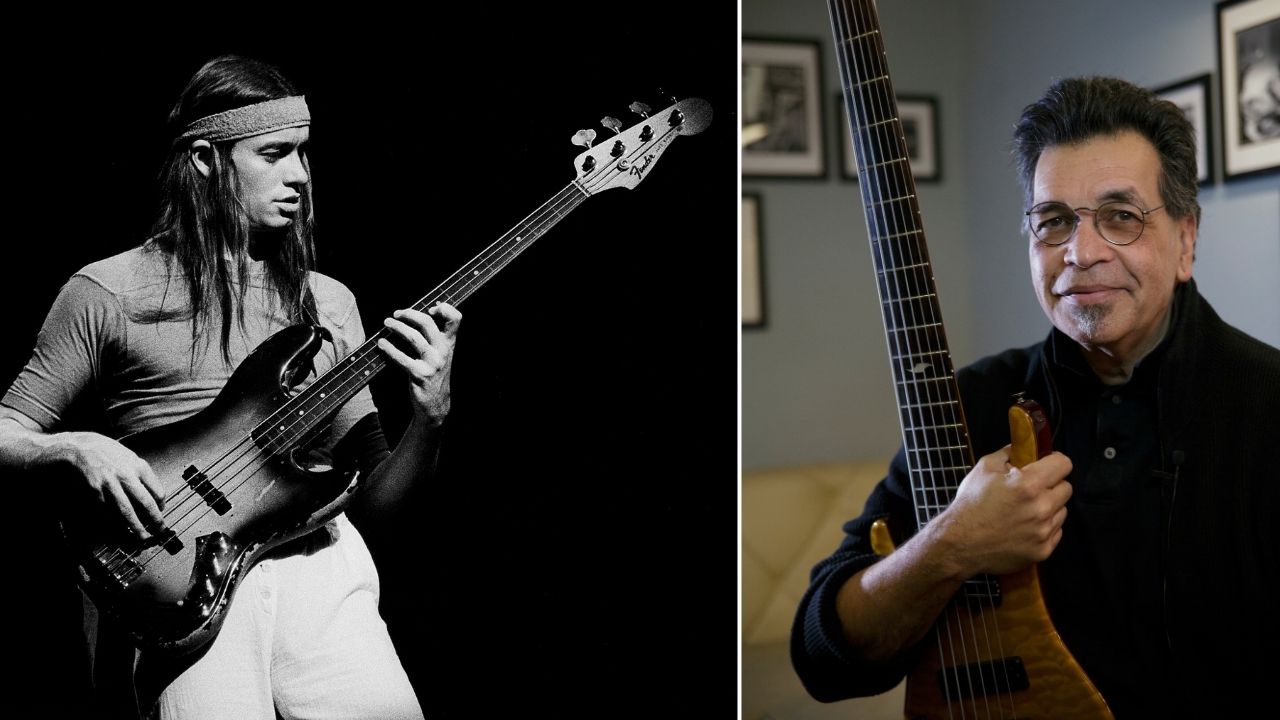Best guitars for beginners 2025: epic entry-level acoustic and electric guitars
Start playing today with our pick of great beginner guitars from Squier, Ibanez, Yamaha and more

Unlike your favorite video game, learning guitar isn’t something you ever truly ‘complete’. It is a lifelong journey that always surprises you as you refine your skills and uncover new techniques, genres, and ways to play. Even after 20-plus years of playing, I’m still learning new things – and that is why we love it so much. But we also remember how tricky it can be to get started, which is why new players need one of the best guitars for beginners to set off on the right foot.
Getting a fast start on the instrument ensures you’ll keep pushing through that difficult first phase, gaining an invaluable hobby and potentially even a music career. There are many cheap guitars out there that come with shoddy finishes, sharp frets, warped necks, and subpar hardware, but it doesn't have to be this way.
We’ve trawled through a huge number of instruments to bring you the best playing, highest quality guitars that will ensure new players keep on coming back for more. Whether you want to learn electric or acoustic, we have included both categories from brands like Yamaha, Ibanez, Squier, and more.
If you’re looking for some more information to help you make a purchase, then head down to the FAQ section at the end of the article. It's got loads of common questions answered by our expert writing team, all backed by decades of experience playing the instrument. If you just want to see the best guitars for beginners available today, then keep scrolling to see our top picks.
Our top picks
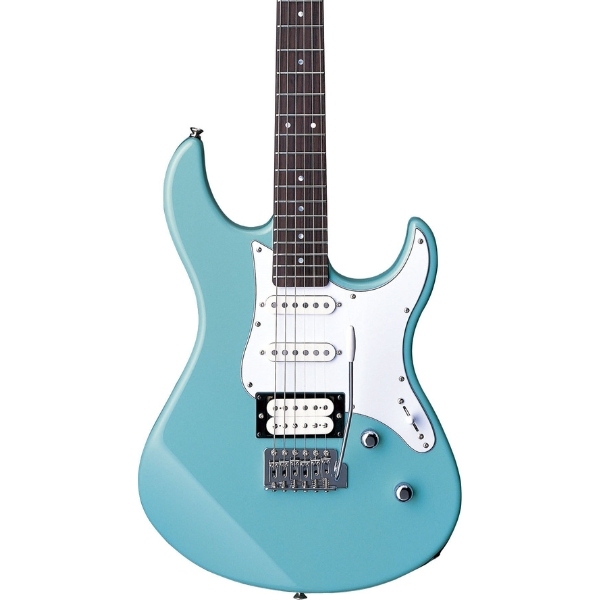
The Yamaha Pacifica 112V has been the go-to guitar for beginners for over two decades. And for good reason; by combining grown-up design with all the tonal versatility a young learner would need, Yamaha has created a near-perfect package.
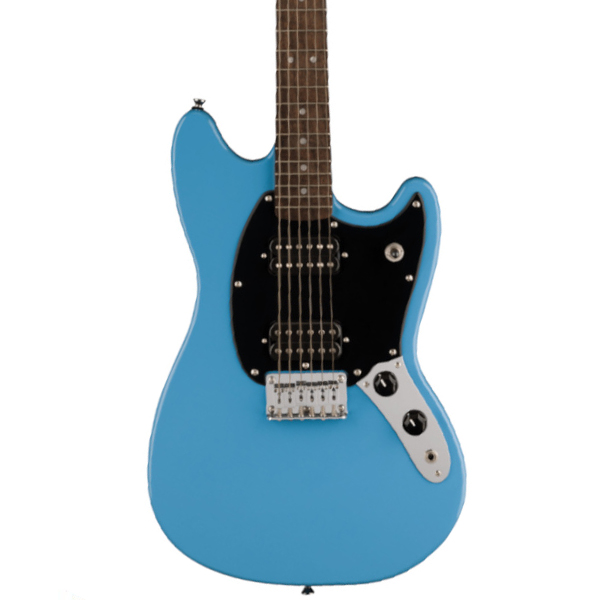
The Squier Sonic Mustang is a great electric guitar for beginners, but it’s arguably the perfect electric guitar for younger beginners in particular. The shorter scale length – 24” – means it isn’t too taxing on small hands, yet plug this thing in and it can make a heck of a racket. In a good way, of course.
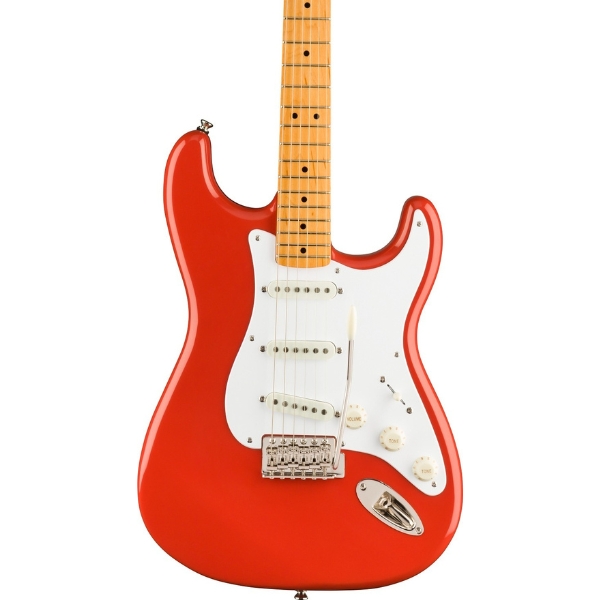
Not everyone who decides to learn the guitar wants to learn on an entry-level model. We all have to work our way up to the elite tier, sure, but there’s a lot to be said for selecting something a little higher quality to begin your playing journey.
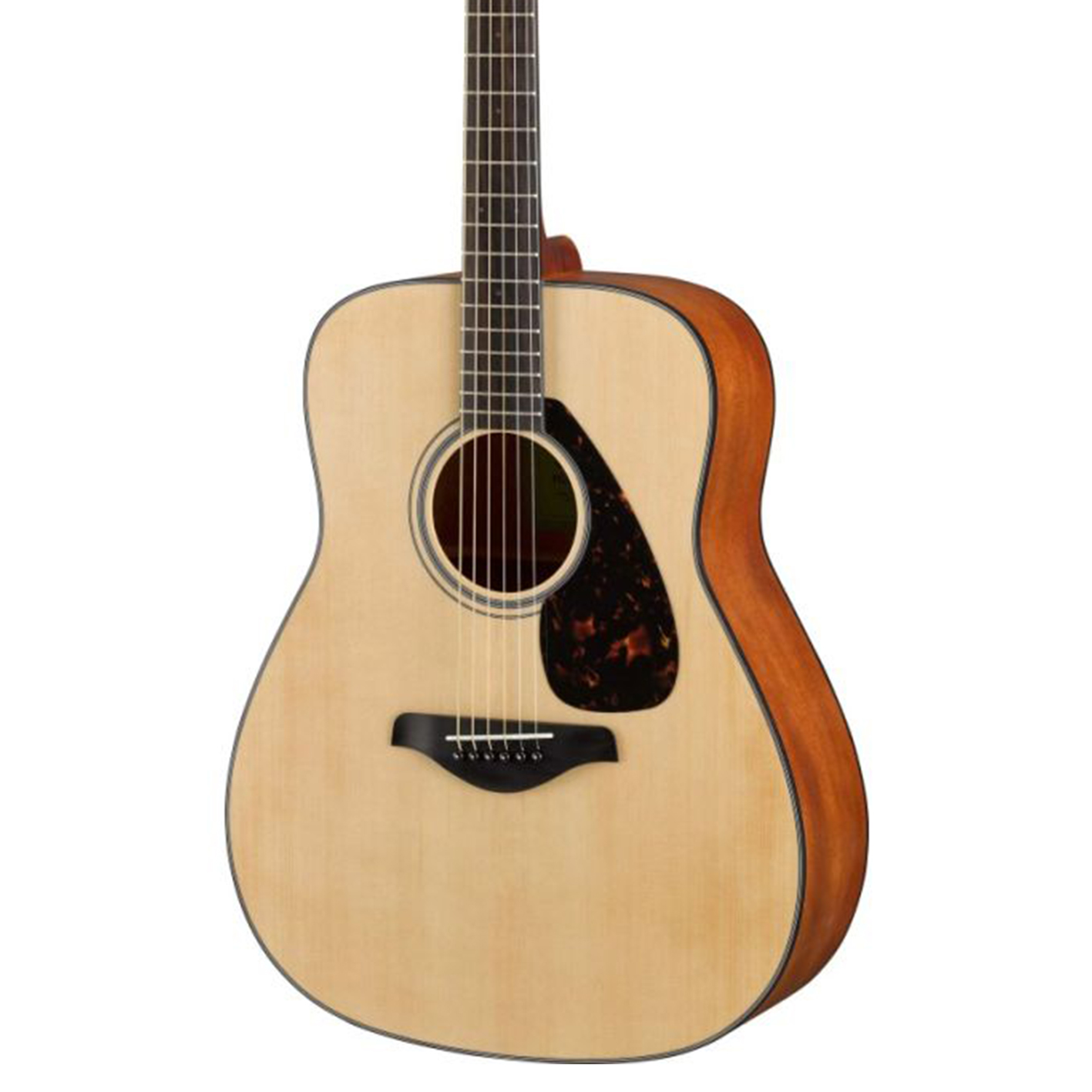
When you think of acoustic guitars at this level, you may assume they’re all cheap, nylon-strung models that fall apart after a month. And, while these guitars do exist, we’d advise steering clear. Especially when there are proper, affordable alternatives like the Yamaha FG800 on the market.

While we’ve included some small-scale guitars here, the Yamaha JR1 is arguably the one to beat when it comes to being the best guitar for kids. This ¾ sized acoustic features a scaled-down body and neck, so it’s easy for smaller hands to work on their chords and develop those good playing habits that will stand them in good stead for the future.
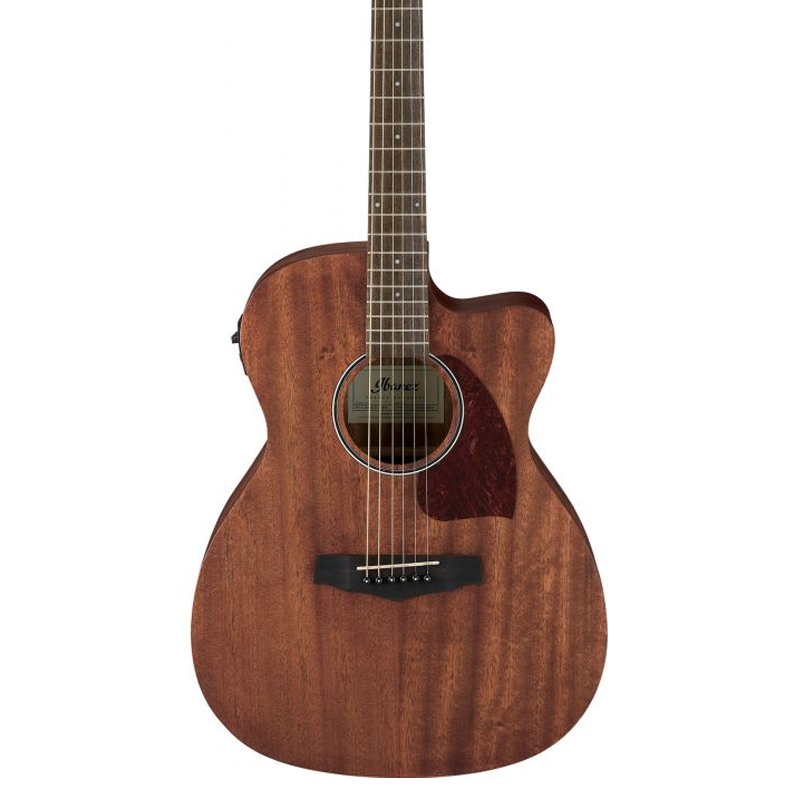
An electro-acoustic guitar is a great option for the new player looking to the future, as it gives you the volume required to play your first shows or jam with others. The Ibanez PC12MHCE is a fantastic choice for the first-timer thanks to its combination of great sound and excellent value for money.
Best beginner electric overall
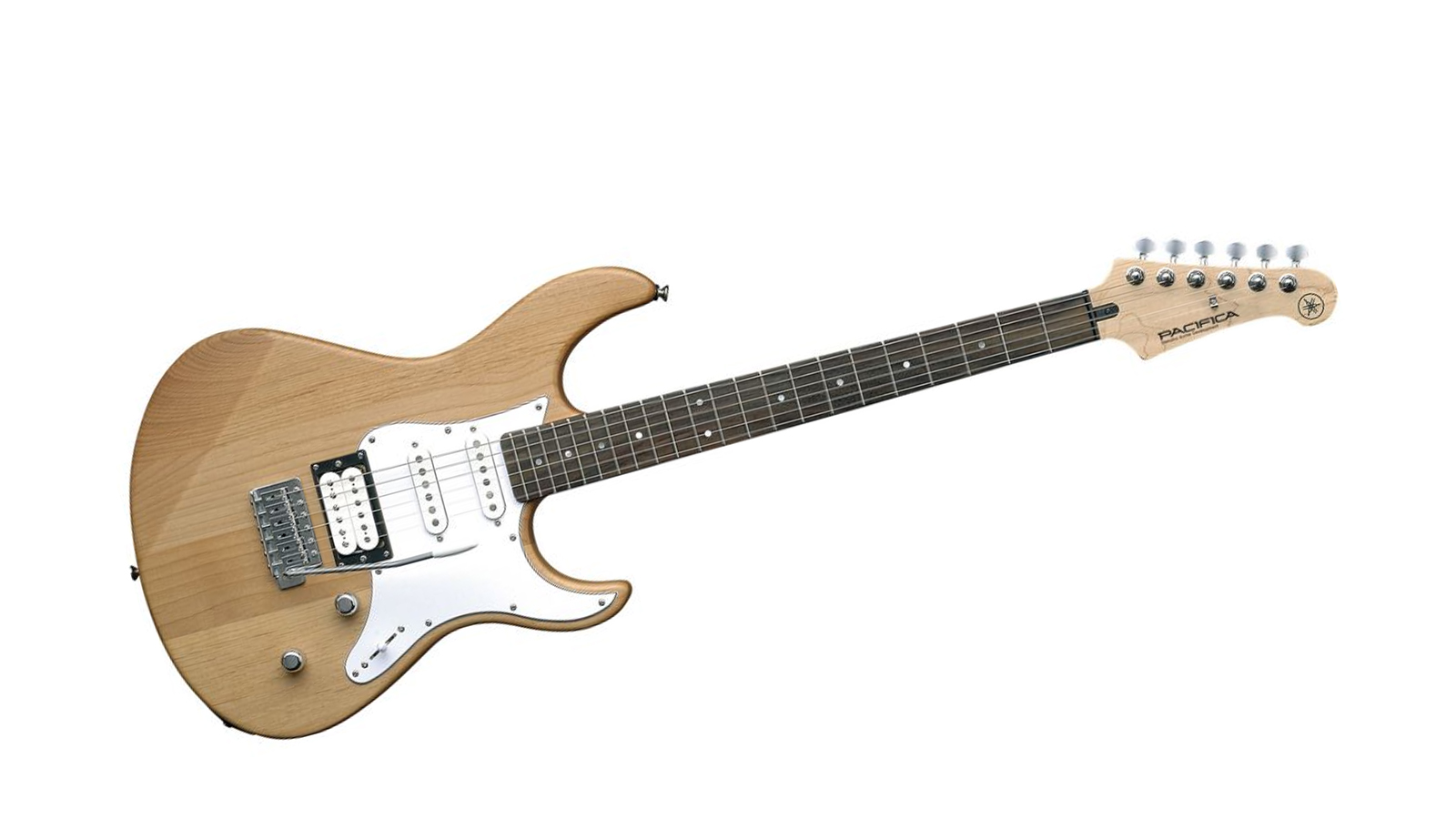
Specifications
Reasons to buy
Reasons to avoid
The Yamaha Pacifica 112V has been the go-to guitar for beginners for over two decades. And for good reason; by combining grown-up design with all the tonal versatility a young learner would need, Yamaha has created a near-perfect package. The bridge humbucker allows you to steer into heavier styles of music, yet the two single coils at the middle and neck allow for different flavors of sound.
What’s always impressed us with the Pacifica line is the way they grow with you; sure, there are cheaper guitars to learn on, but as you progress, you’ll find their shortcomings holding you back. The Pacifica 112, on the other hand, has been designed as a grown-up guitar with all the features you’ll need from the start.

"There are plenty of reasons why the Yamaha Pacifica 112V is still one of the best options for beginners. Look past that learner image, however, and you’ll find a versatile, well-made guitar that will bring something extra to any player’s roster."
Read the full Yamaha Pacifica 112V review
Best electric for kids
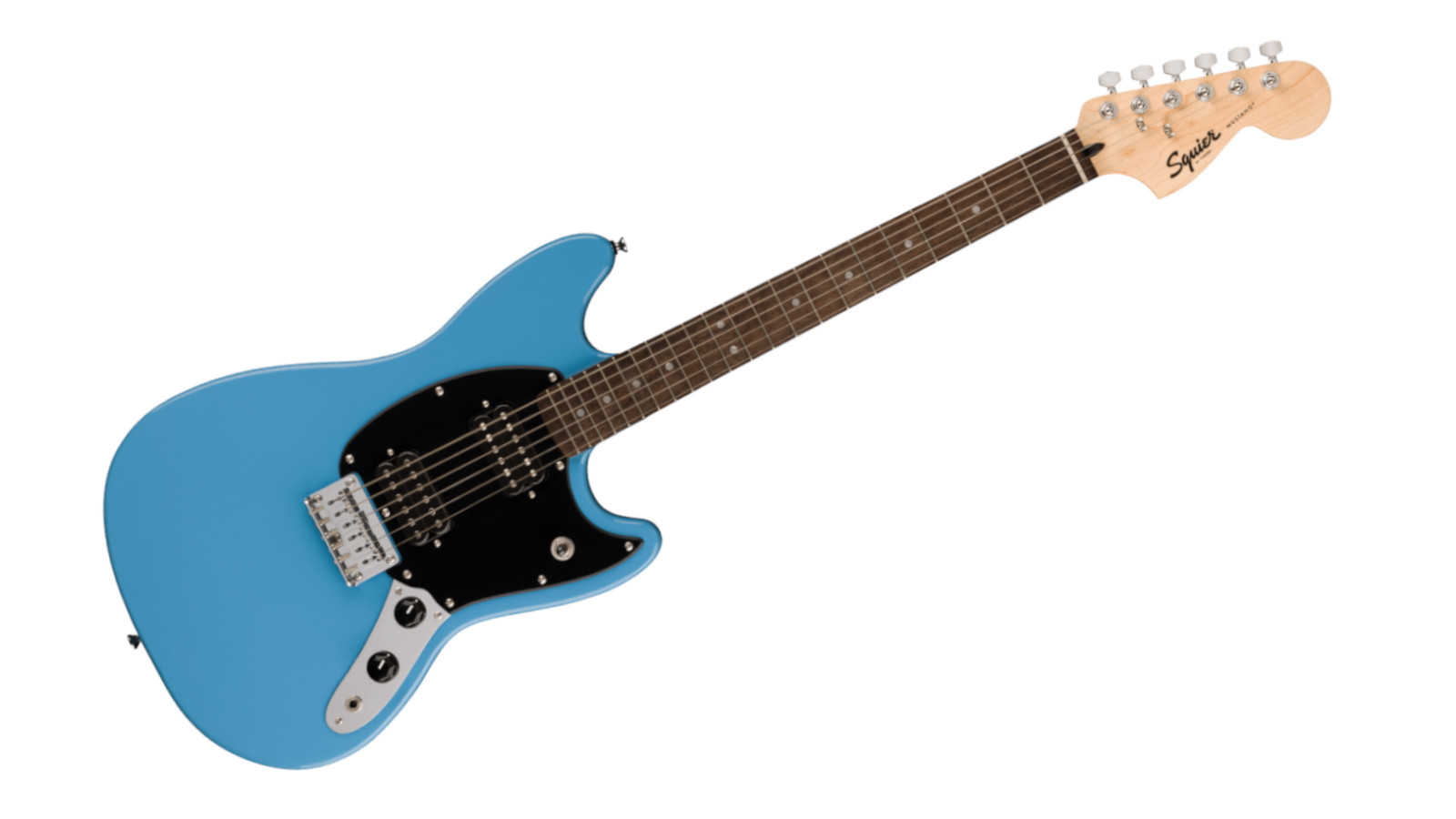
2. Squier Sonic Mustang
Our expert review:
Specifications
Reasons to buy
Reasons to avoid
The Squier Sonic Mustang is a great electric guitar for beginners, but it’s arguably the perfect electric guitar for younger beginners in particular. The shorter scale length – 24” – means it isn’t too taxing on small hands, yet plug this thing in and it can make a heck of a racket. In a good way, of course.
The choice of poplar for the body makes for a very lightweight guitar, meaning you can concentrate on improving your skills without feeling like you’re wrestling a big block of wood, and the two humbuckers are ideal for playing big, punky chords and riffs.
There are two finish options to choose from – California Blue or Flash Pink – meaning that whatever option you go for, standing out from the crowd is going to come naturally.

"There's no argument to be had with the build, sound or playability of this entry-level offset, and with its shorter scale, it might just be the ideal beginner guitar for young players."
Read the full Squier Sonic Mustang review
Best electric for adults
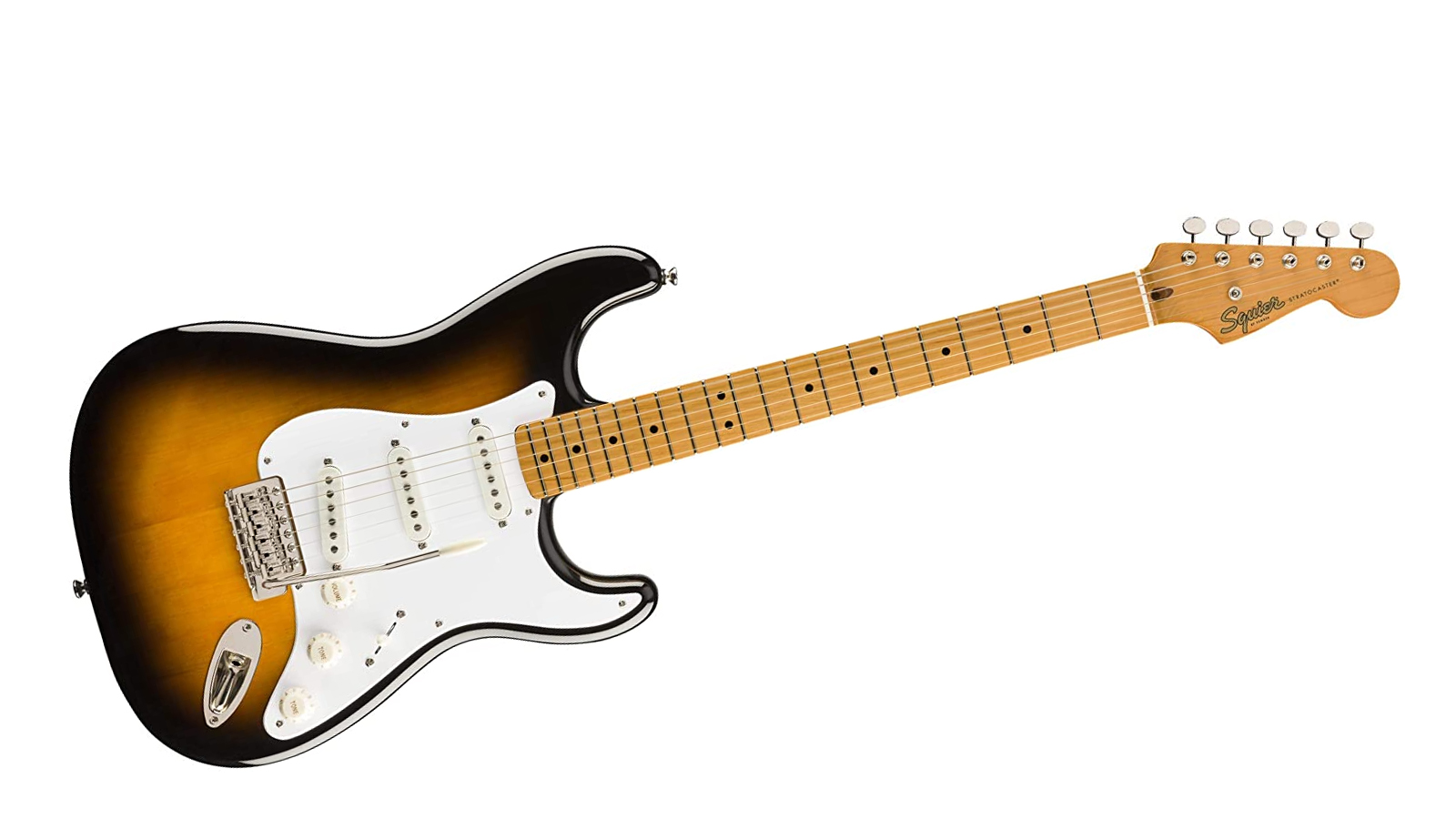
Specifications
Reasons to buy
Reasons to avoid
Not everyone who decides to learn the guitar wants to learn on an entry-level model. We all have to work our way up to the elite tier, sure, but there’s a lot to be said for selecting something a little higher quality to begin your playing journey.
The Squier Classic Vibe 50s Stratocaster is a superb choice in this regard, with its era-specific appointments and vintage hardware pointing to a very ‘classic’ guitar indeed. While its understated charm might not appeal to more flamboyant players, its timeless class has certainly stood the test of time.
Look past the aesthetics, however, and you’ll find a comfortable, easy-to-play instrument that has enough tonal versatility to cover a lot of bases. It’s not the cheapest on this list, but it’s easily one of the highest-quality models at this price point.

"Squier consistently produces some of the very best affordable Strats money can buy, and this iteration of its Classic Vibe series proves that cheap does mean cheerful. The '50s specs of this model help provide an exciting and entertaining throwback to the genesis era of the Stratocaster at an accessible and affordable price tag."
Read the full Squier Classic Vibe 50s Stratocaster review
Best for versatility
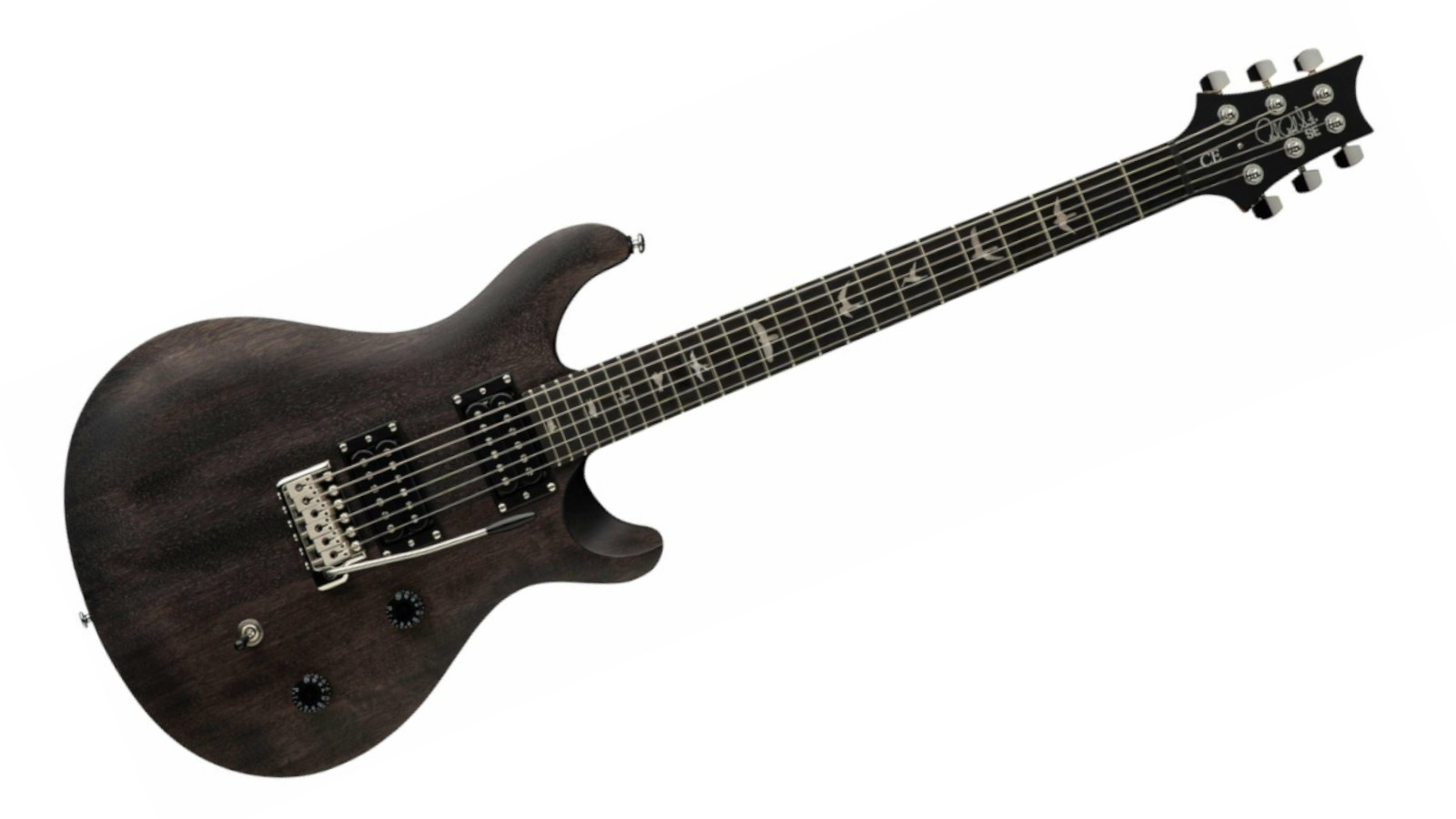
4. PRS SE CE 24 Standard Satin
Our expert review:
Specifications
Reasons to buy
Reasons to avoid
For many of us, the desire to learn guitar stems from a love of heavy music. The electric guitar is synonymous with heavy genres, and it has inspired millions to pick up an ax. If you are looking to get started with the right guitar, the PRS SE CE 24 Standard Satin is one of the best choices for the job.
The SE CE 24 comes equipped with humbuckers, which are known for their powerful tone and ability to handle distortion and gain with ease. But this guitar is much more versatile than that – thanks to a push/pull switch on the tone control, it splits the humbuckers into single coils, giving beginners a wealth of tonal options to experiment with.
Additionally, the Standard Satin range is the most affordable line PRS has ever produced, making this highly sought-after brand accessible to those just starting out. However, the satin finish is more prone to dings and marks since it lacks the gloss protection of more expensive models, so you'll need to handle your new guitar with care.

"For any player, at any level, needing to cover a lot of sounds, this really takes some beating: the pared-down essence of PRS, if you like, and a guitar we really can’t fault. Try one of these before someone realises they’ve made a mistake with the price."
Read the full PRS SE CE 24 Standard Satin review
Best acoustic overall
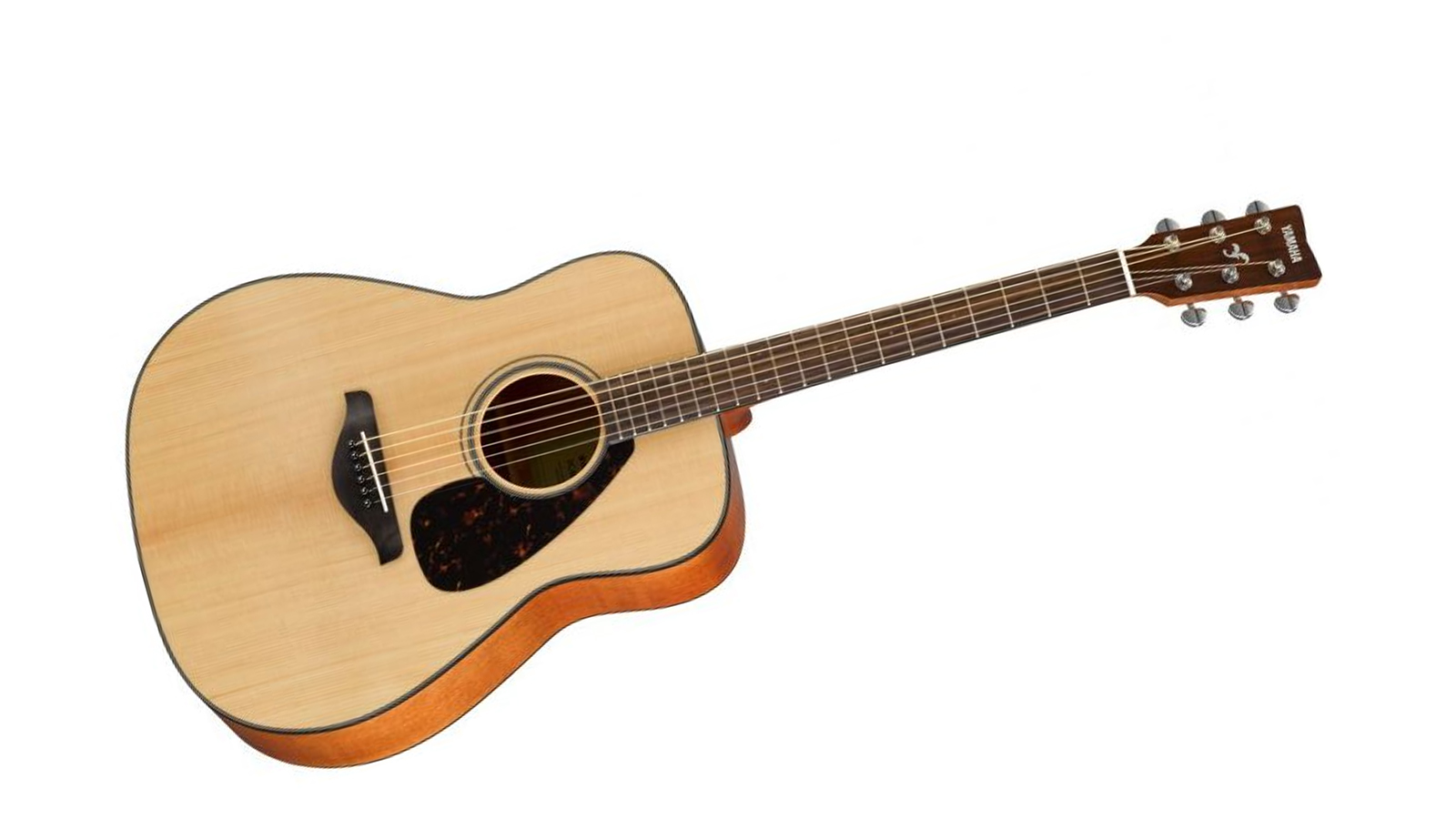
Specifications
Reasons to buy
Reasons to avoid
When you think of acoustic guitars for beginners, you may assume they’re all cheap, nylon-strung models that fall apart after a month. And, while these guitars do exist, we’d advise steering clear. Especially when there are proper, affordable alternatives like the Yamaha FG800 on the market.
The FG800 is a dreadnought-style guitar, so it has a large, deep body which, in conjunction with the steel strings, projects a gloriously rich tone with loads of character. This is a guitar you can take your first steps on, and we are confident it will stay with you long into the future.
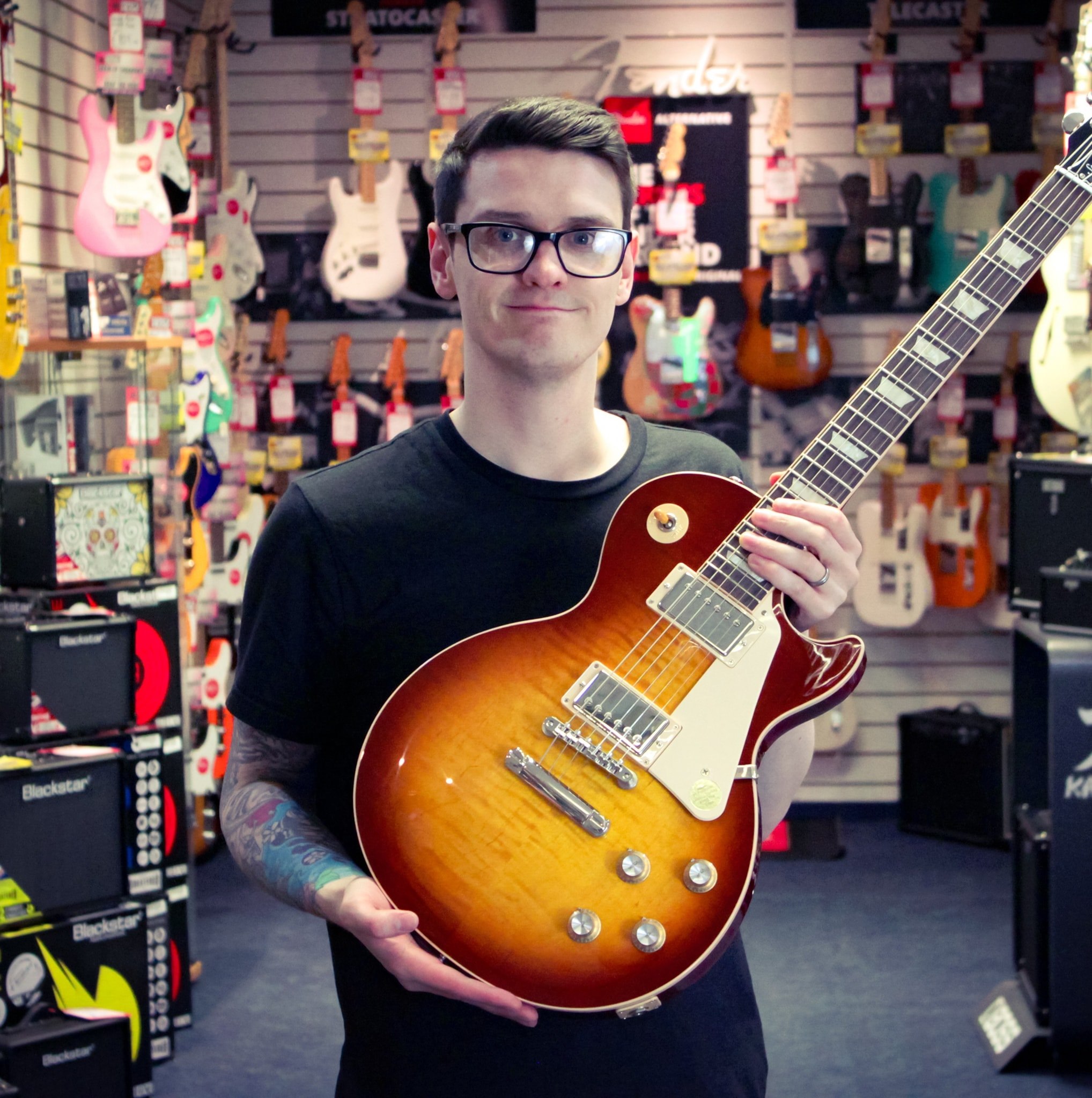
"There’s no doubt about it, the Yamaha FG800 is one of the greatest beginner acoustic guitars of all time. Its solid top helps deliver a rich, full-bodied tone usually reserved for more expensive instruments. In addition, the smooth neck is comfortable, extremely playable, and perfect for players at the beginning of their musical journey."
Read the full Yamaha FG800 review
Best acoustic for kids
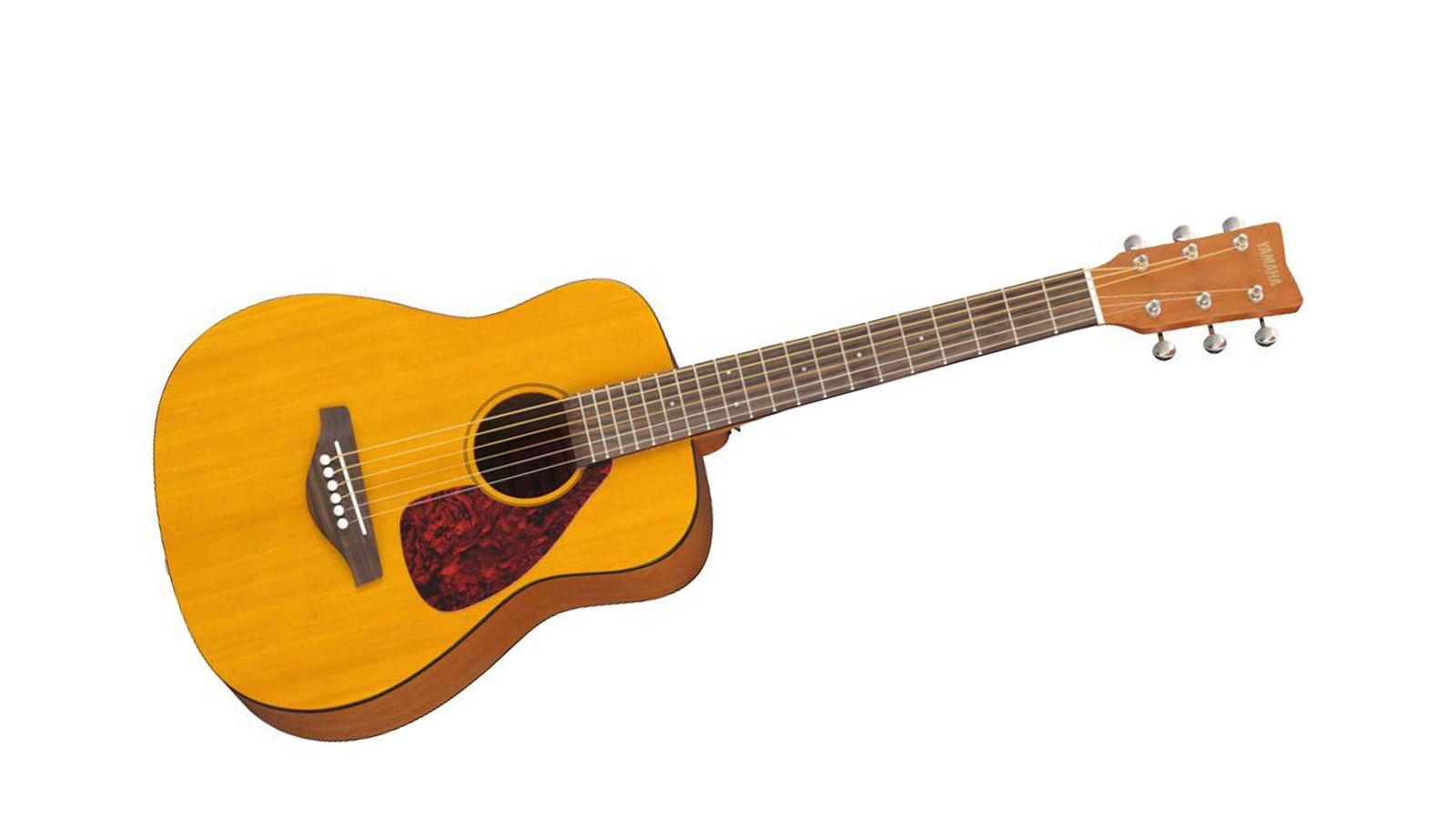
6. Yamaha JR1
Our expert review:
Specifications
Reasons to buy
Reasons to avoid
While we’ve included some small-scale guitars here, the Yamaha JR1 is arguably the one to beat when it comes to being the best guitar for kids. This ¾ sized acoustic features a scaled-down body and neck, so it’s easy for smaller hands to work on their chords and develop those good playing habits that will stand them in good stead for the future.
As well as younger learners, the Yamaha JR1 makes a great travel guitar, aided by the included gig bag, making this a decent all-rounder for beginners and more established players.
Best acoustic for adults
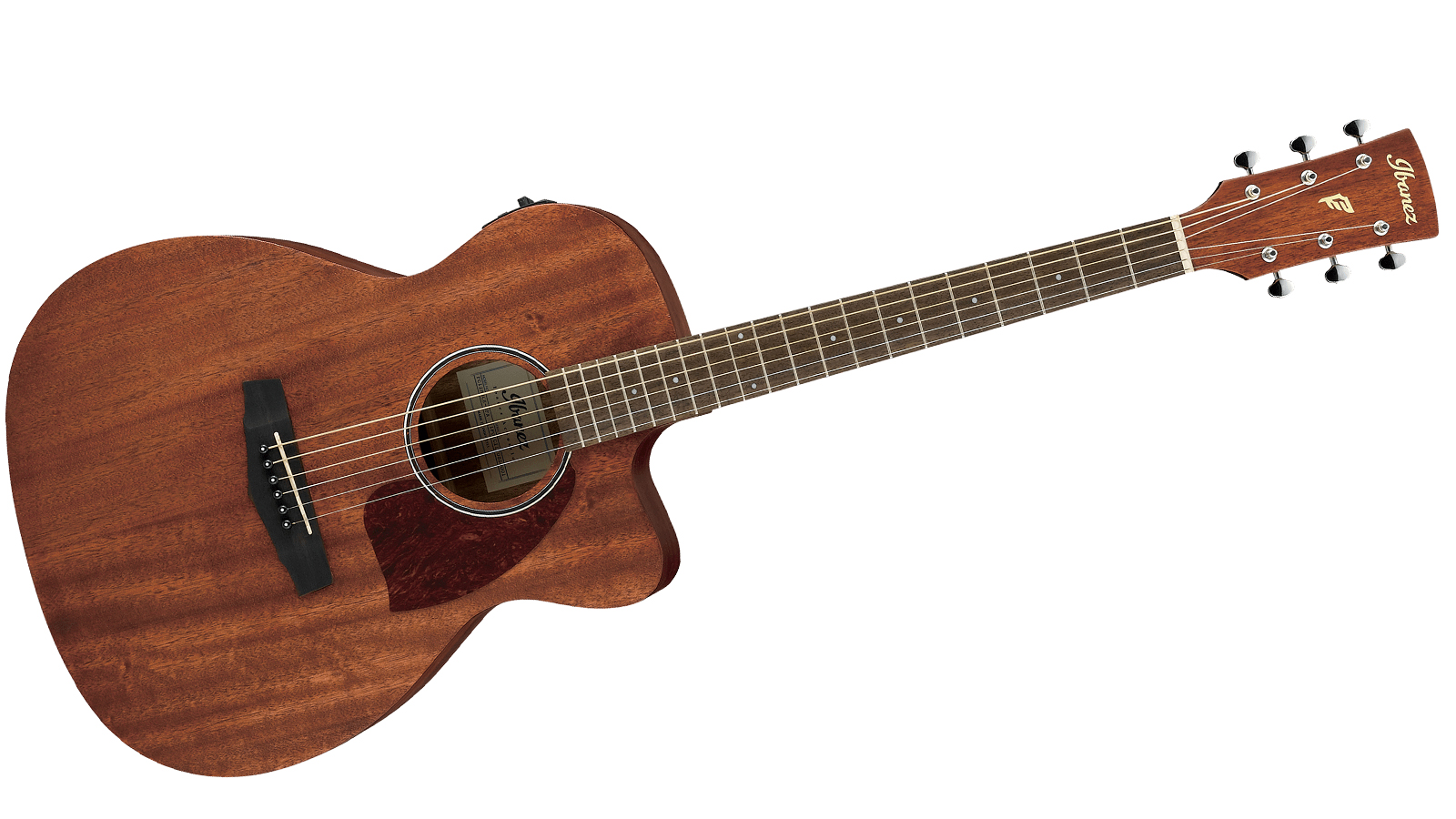
7. Ibanez PC12MHCE
Our expert review:
Specifications
Reasons to buy
Reasons to avoid
An electro-acoustic guitar is a great option for the new player looking to the future, as it gives you the volume required to play your first shows or jam with others. The Ibanez PC12MHCE is a fantastic choice for the first-timer thanks to its combination of great sound and excellent value for money.
It’s got a nice midrange tonality, so it will work just as well for your first chords as it does for more complex fingerpicking. The cutaway gives great upper fret access, and the whole neck feels really smooth to play, a feature of many Ibanez guitars.
The built-in electronics offer a nice and transparent tone when plugged in, plus you get a built-in tuner to ensure you’re always ready to rock. An excellent option for the beginner guitarist who wants to move on to live performances.
Best classical
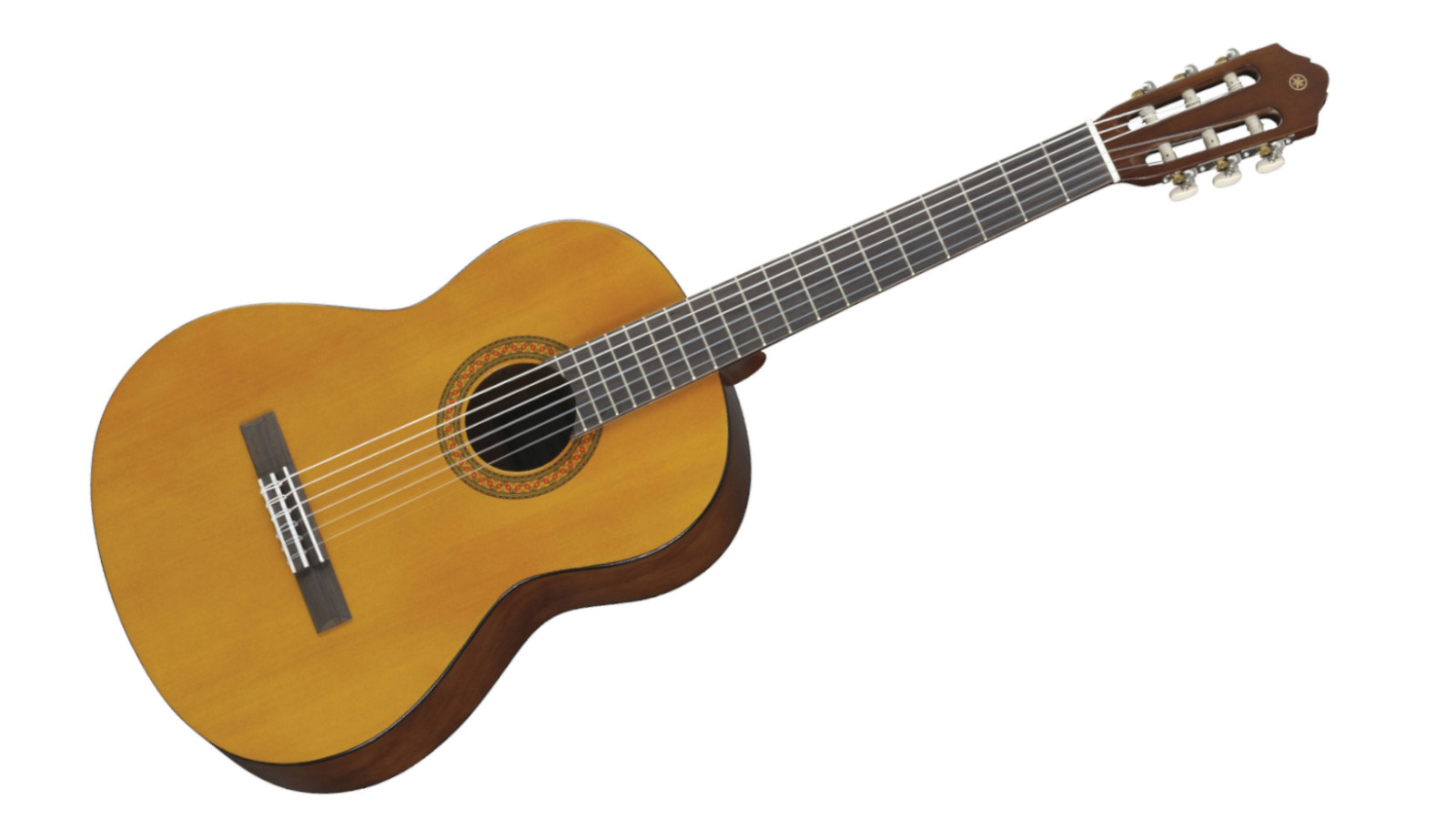
8. Yamaha C40II
Our expert review:
Specifications
Reasons to buy
Reasons to avoid
If you are looking for an affordable and reliable classical guitar to kickstart your playing, the Yamaha C40II should be at the top of your list. For over 30 years, this beginner-friendly guitar has been helping players get their feet wet in the world of classical and flamenco music, and it is still going strong.
One of the things that makes the C40II a standout for beginners is its nylon strings, which are much easier on the fingers than harsh steel strings. This makes it perfect for newcomers or those with less calloused fingertips – whether you are just learning the ropes or trying to find something that is more comfortable to play.
We found the action low, making it easy to play right out of the box, and the wide string spacing and neck are a dream for fingerpicking. However, if you have smaller hands, chords may prove to be trickier. The other downside is the lack of fret markers, which may take a bit of getting used to.

"If you’re after a beginner classical guitar, there truly is no better option than the C40II. With its excellent setup, durability, affordability, and consistent tone, the C40II has been the starting point for many guitarists over the past 30 years and shows no signs of losing its appeal. While there are minor overlooked touches such as scratchy frets and slightly sharp fret ends, these issues are not unexpected at this price point."
Read the full Yamaha C40II review
FAQs
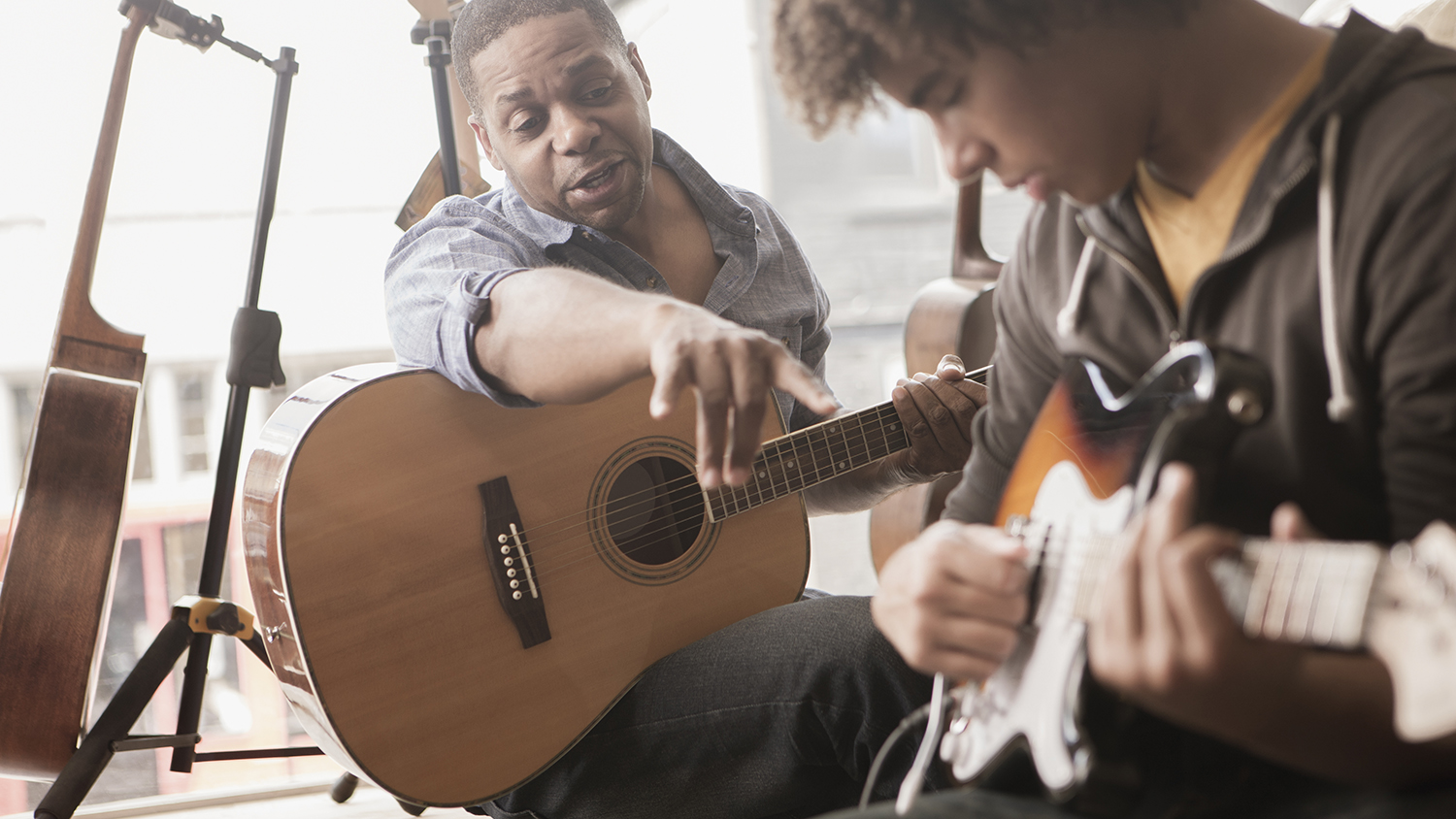
Buying your first guitar is a big step, so you need to make sure it’s the right one for you. There are loads of different choices you can make so arming yourself with the right knowledge is key to ensuring you buy the right instrument for you.
Should I learn acoustic guitar or electric guitar first?
Traditionally beginner players began their journey on the acoustic guitar, but just because something is traditional doesn’t mean it’s right for you. We personally began learning on an acoustic guitar, but that was over twenty years ago and since then a lot has changed. Which instrument you start on is no longer the taboo subject it once was, so if either appeal to you more then go for it!
We reckon the electric guitar is easier to learn on for a few reasons, first of all, the body is nice and thin, so the guitar will be closer to you when you play. Typically electric guitar necks are thinner than their acoustic counterparts, thus you’ll find fretting chords easier. Finally, electric guitar strings are thinner than acoustic guitar strings, so don’t require the same amount of hand strength to press down.
However, we will caveat this with a few things when it comes to learning on an acoustic guitar for beginners. Exactly because they are more difficult to play, starting with acoustic will enable you to progress more quickly, developing a stronger core of hand strength and dexterity. Just like the famous slogan, ‘train hard, fight easy’ taking the tougher option when you initially begin to play will have you reaping the rewards later down the line.
What size guitar should I get?
Electric guitars have different body shapes, but in terms of size, they tend to be pretty similar across the board. Electric guitars usually have thin bodies which means they’re considered relatively small, especially when compared to some acoustic guitar body types. You can get a short-scale guitar, which has a smaller length between the bridge and the headstock, making it easier for younger players and those with smaller dimensions to get to grips with.
Acoustic guitar body sizes are numerous and some of them are big enough that even a fully grown adult can struggle to handle them. Dreadnoughts and jumbos are the biggest size guitars, whereas parlor and grand auditorium styles offer a smaller size for younger players. You can also get ½ and ¾ size guitars, which are great for very young players, offering a smaller body size and scale length.
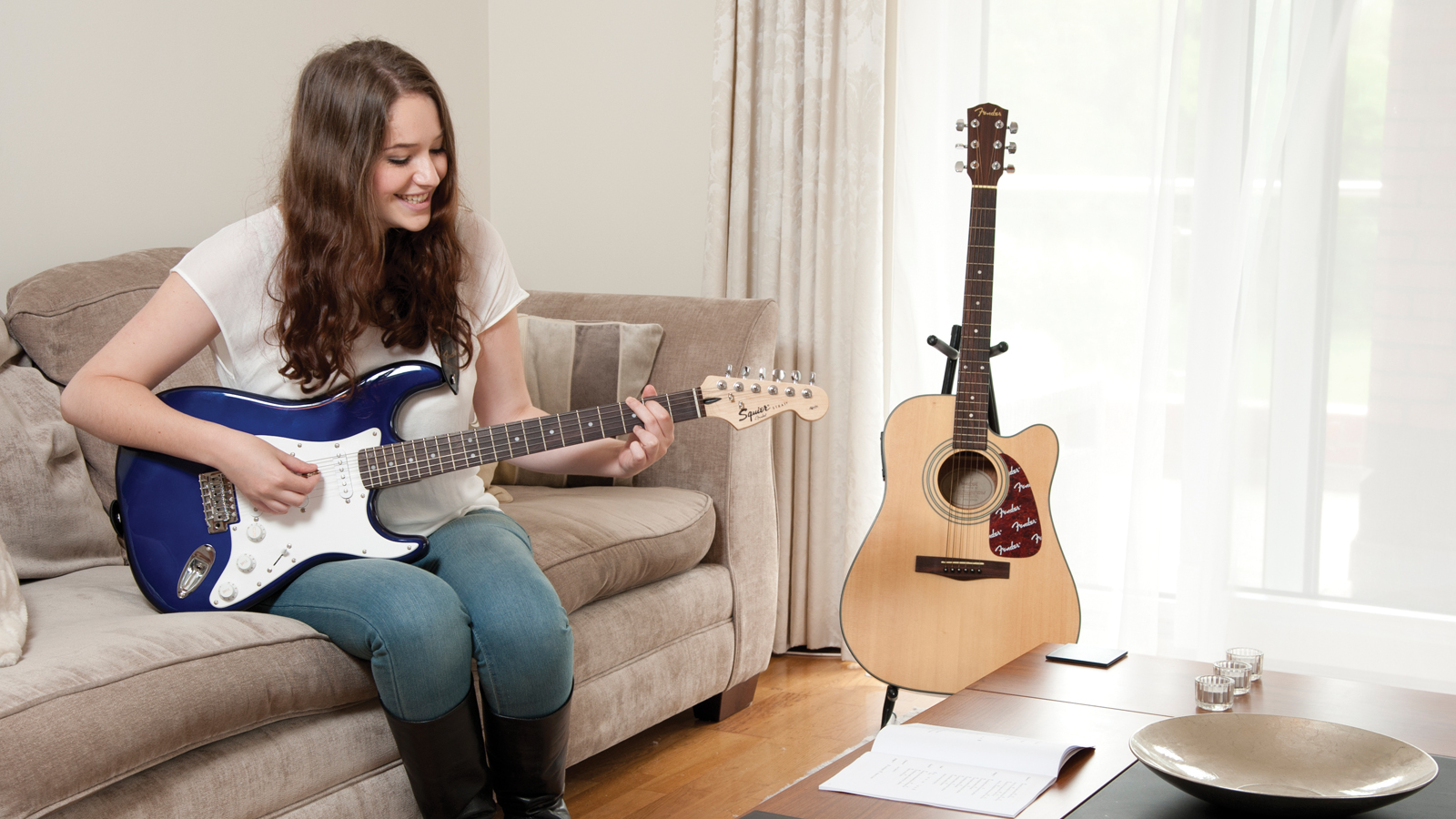
How much should I spend on my first guitar?
All of the guitars here are under $/£500, and many of them are below the $/£300 mark. We wouldn’t recommend spending above this on a first instrument, as it’ll be an expensive mistake if you decide that the guitar isn’t for you after all! Instruments around the $/£300 mark are pretty much guaranteed to be great quality, and so long as you’re buying from a reputable brand, those that fall lower than this price point will still do the job just fine.
Do I need any accessories like a tuner or a strap?
We would definitely recommend getting a clip-on tuner alongside your first guitar purchase. It’s one of the most important accessories and you’ll get a lot of use out of it. No guitarist worth their salt will be caught without a tuner, and it also helps you understand your first bits of music theory too.
Other accessories like guitar straps and guitar cables are instrument dependent. Most acoustic guitars are usable without a guitar strap thanks to their large body size. Electric guitars on the other hand can be unwieldy to play sitting down without a strap, so it’s worth investing in one if you have an electric as your first guitar.
If you’re going the electric guitar route, then you’ll have to get yourself a beginner guitar amp to go with it, as well as a guitar cable to plug it in. These are worth bearing in mind when you’re budgeting for your first purchase, as your guitar won’t be at its best without them.
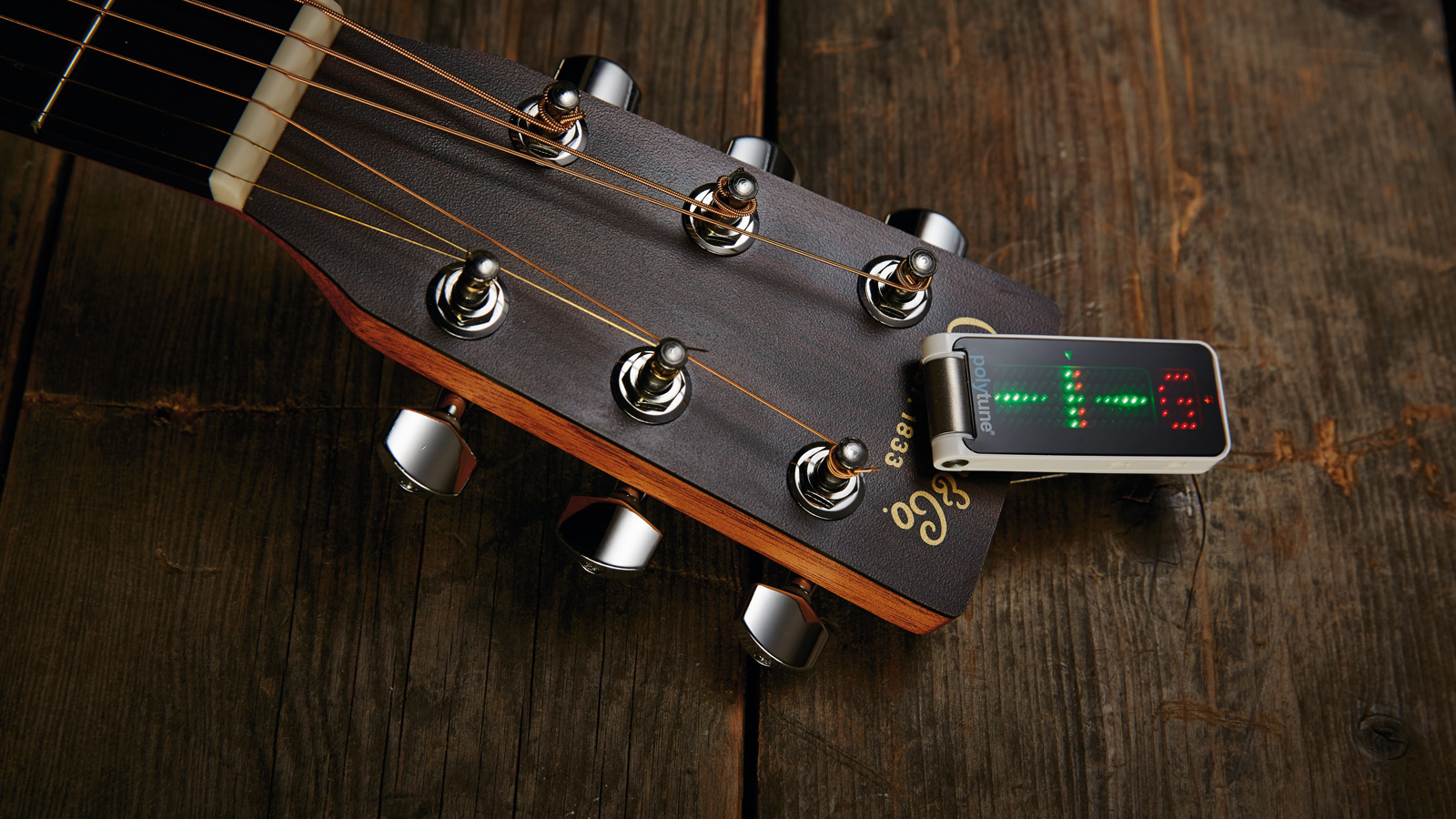
Should I take lessons before I buy a guitar?
Having your own guitar is incredibly important whilst you’re learning. If you’re taking lessons you’ll need to practice what you’ve learned, so we’d definitely advise buying a guitar to use alongside your lessons. If you’re worried about the cost of lessons, don’t worry because there are loads of great online guitar lessons platforms you can use to learn from the comfort of your own, as well as at your own pace.
You can make savings on guitar lessons online with our Guitar World exclusive promo codes below:
Fender Play: 50% off an annual subscription
Sorted a free trial but now you want to continue getting all the benefits of Fender Play lessons beyond your trial? Fender is offering 50% off an annual plan for all Guitar World readers, dropping the price from $99.99 to just $49.99. Just add the code guitarworld50 at checkout.
Guitar Tricks: Save 50% off your first month
Enjoy your first month of Guitar Tricks for half price using the exclusive Guitar World code GW50MONTH at checkout. Guitar Tricks features plenty of great content for beginners with an absolutely massive 11,000 videos across the site on pretty much anything you can think of.
TrueFire lessons: Save 30% with code GWTF30
TrueFire includes a whopping 50,000 video lessons taught by industry-leading teachers, Grammy Award-winning artists, and world-class touring musicians. In case that wasn't good enough, you can save 30% off an All-Access subscription and all courses with the exclusive code GWTF30.
Simply Guitar: Save 20% at this link
If you'd prefer to learn on a smartphone or tablet, Simply Guitar has a fantastic app with a fun, playful approach to learning the instrument. Right now you can sign up for a year and save $30, dropping the annual cost from $150 down to just $120.
How we choose
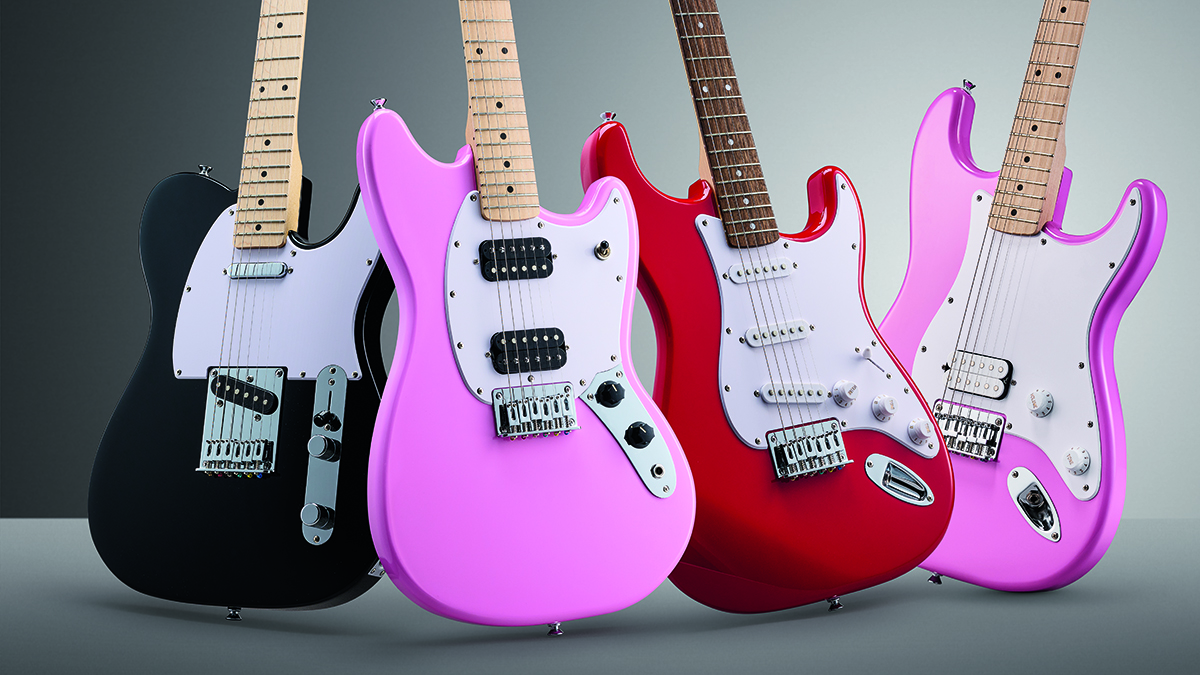
Here at Guitar World, we are experts in our field, with many years of playing and product testing between us. We live and breathe everything guitar and bass related, and we draw on this knowledge and experience of using products in live, recording and rehearsal scenarios when selecting the products for our guides.
When choosing what we believe to be the best guitars for beginners right now, we combine our hands-on experience, user reviews and testimonies and engage in lengthy discussions with our editorial colleagues to reach a consensus about the top products in any given category.
First and foremost, we are guitarists, and we want other players to find the right product for them. So we take into careful consideration everything from budget to feature set, ease of use and durability to come up with a list of what we can safely say are the best guitars for beginners on the market right now.
Read more about our rating system, how we choose the gear we feature, and exactly how we test each product.
Why trust us?
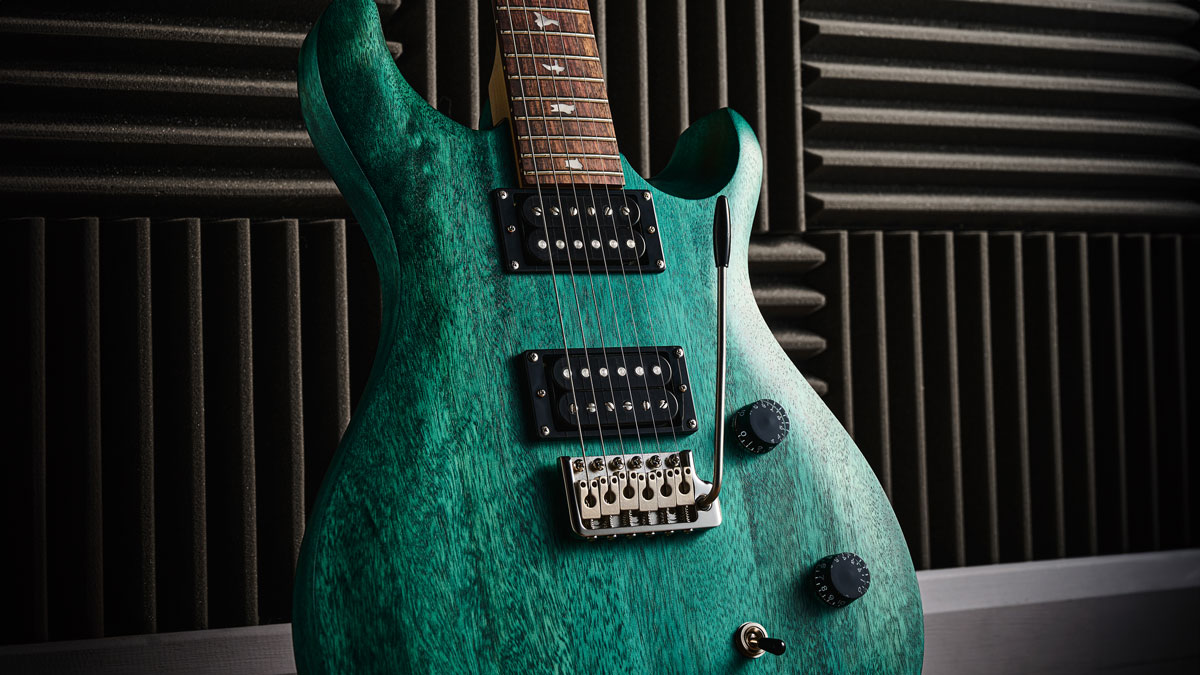
☑️ A global audience of 3.8 million guitarists monthly
☑️ 1,200+ reviews on GuitarWorld.com
☑️ 30+ years of product testing at Guitar World
Guitar World boasts over 44 years of expertise and stands as the ultimate authority on all things related to guitars. The magazine and website feature expertly written gear round-ups and top-quality, authoritative reviews penned by a team of highly experienced industry professionals.
Guitar World's inaugural print issue hit the shelves in July 1980, and ever since, it has been captivating players and enthusiasts with engaging lessons, insightful interviews with the biggest guitar heroes, and priceless buying advice for newbie players.
Furthermore, GuitarWorld.com continues this legacy online and serves as the hub of the world's foremost authorities on guitar playing. The site not only hosts content from Guitar World but also showcases articles from respected publications such as Guitarist, Total Guitar, Guitar Techniques, and Bass Player. With a reach extending to 3.8 million players each month, GuitarWorld.com is a go-to destination for guitar fanatics globally.
Related buying guides
You can trust Guitar World
- The best pedalboards for organizing your guitar effects
- Best guitar picks: find the right plectrums for you
- 12 killer cheap guitar pedals you need to try
- Practice in peace with the best headphones for guitar amps
- Meet the best electric guitars under $1,000
- Play more comfortably with the best guitars for small hands
All the latest guitar news, interviews, lessons, reviews, deals and more, direct to your inbox!
Chris Corfield is a journalist with over 12 years of experience writing for some of the music world's biggest brands including Orange Amplification, MusicRadar, Guitar World, Total Guitar and Dawsons Music. Chris loves getting nerdy about everything from guitar gear and synths, to microphones and music production hardware.
- Matt McCrackenJunior Deals Writer
- Ross Holder




